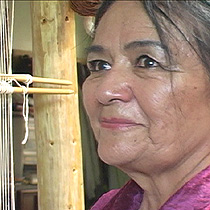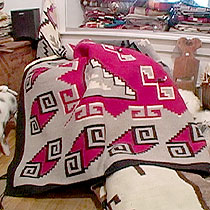2007年VOA标准英语-Navajo Weaving Traditions Endure(在线收听)
Albuquerque, New Mexico
08 August 2007
Navajo rugs are highly regarded for their fine hand weaving and designs. They are often expensive and are considered by many to be quite beautiful. Producer Zulima Palacio traveled to Albuquerque, New Mexico to talk to one of the most recognized Navajo weavers as well as an active promoter of their artistic traditions. Jim Bertel narrates the story.
 |
| Pearl Sunrise teaches and carries on the cultural traditions of the Navajos |
The intricate secrets of an elaborate weaving tradition, together with the spiritual meaning of colors and designs are now part of her life.
Pearl Sunrise was born and raised in a Navajo reservation where she learned as a child about the care of sheep, wool treatment and spinning. But most important, she says, weaving taught her about keeping one's harmony and balance. "There is like a whole life value that teaches you in your creative process and your connection to your ancestors. Every step of the way in creating a rug, the wool, you have to keep yourself in balance in order to work with it."
 |
| Her rugs are made with natural dyes; many are on display in museums |
Pearl finished her first small rug by the age of 9. But soon after that she was forced to leave her beloved Navajo reservation in order to study English and go to school. She graduated with a master's degree in education and since then she has been teaching art, weaving, and the Navajo language.
She now lives in Albuquerque, New Mexico near her three daughters and two grandchildren. Sunrise has passed on the weaving tradition to her daughters, but none do it fulltime.
Sunrise's work has won many honors including the living artist award from the American Indian Market in Santa Fe.
At the Museum of Indian Arts & Culture in Santa Fe, Director Shelby Tisdale says Pearl Sunrise is unique because of the variety in her work. "Pearl Sunrise doesn't do just one particular style of woven, her wovens are varied and incorporate a lot of styles, which I think is unique, because most weavers stayed within the type of weaving or style from their particular area. I think she is another one of those artists that goes beyond the boundaries and does a lot of experimental work."
When Sunrise is not teaching or weaving, she is taking care of her grandson, singing old Navajo children's songs – passing along another long-held Navajo tradition.